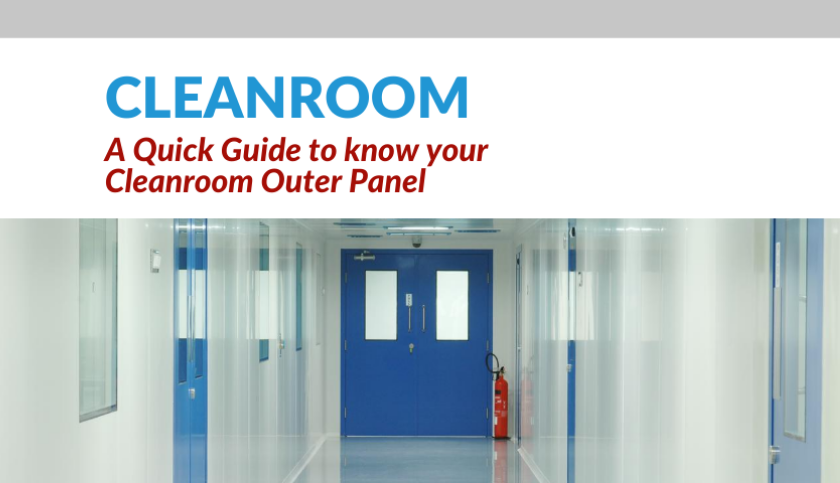A Quick Guide to know your Cleanroom Outer Panel

Hence when we approach prospective or existing clients, we focus their attention on the factors based on which the outer sheets are decided, and the factors vary from usage, MOC, facility as well as commercial impact. In this blog, we analyse some crucial elements and help in understanding the decision-making criteria for choosing an outer panel for cleanrooms.
Various solutions can be procured from a wide range of panels available.
A) Based on Material of Construction
- MS Powder coated
- ACP (Aluminium composite panels)
- GI (Galvanized Iron)
- Prepainted GI (PPGI)
- Powder coated GI (PCGI)
- SS matt finish (Stainless Steel)
- HPL (High-Pressure Laminate)
- GRP (Glass Reinforced Plastic) or FRP (Fibre Reinforced Plastic)
Each panel has a different purpose and based on which the selection is made. The material to be used in panel selection is chosen depending on the type of environment, i.e. fire resistant, heat resistant, moisture resistant, noise reduction etc. The economic consideration increases as we move from class 1 to class 8.
 MS Powder coated Panels
MS Powder coated Panels
The cheapest option of the available materials, MS powder-coated Panels are used principally only in the storage or unclassified area of a pharmaceutical facility. Aesthetically, this helps to maintain the uniformity with the classified area.

- GI (Galvanized Iron) Sheets
GI sheets are used primarily in cleanroom spaces termed as dead areas, or unexposed areas, i.e. the face of a panel used for wall cladding, or front of the panel towards the ceiling in a non-walkable area.

- Pre-painted GI (PPGI) and Powder-coated GI (PCGI)
As opposed to GI, PCGI, or PPGI differs in the coating thickness over the GI sheet. In the case of PPGI, there is a thin coating layer that consists of 18-20 microns, and continuous lines are used in the sheet manufacturing facility, and (check the meaning). In contrast, PCGI is coated with magnetically charged particles, and the thickness is around 0.6-0.8 mm. This increase in thickness ensures durability and longer shelf life (by several years) of PCGI panels.

- HPL (High-Pressure Laminate) and GRP (Glass Reinforced Plastic) Panels
HPL and GRP panels are sturdy, have superior chemical and fire resistance, and also offer an aesthetic appeal in comparison with other types of panels. One of the main reasons to choose them for a cleanroom manufacturing facility is the ability to withstand corrosion to cope up with the fumes of acids and vapours. HPL panels can undoubtedly withstand a higher temperature of approx. 250 C. Both HPL and GRP Panels are scratch-resistant (AA special characteristics), hence many industries prefer to use over other materials.

- SS matt finish (Stainless Steel)
Modular panels also are made from SS 304, provide excellent corrosion resistance to cope up with the fumes of various chemicals generated during processing. The SS 304 panels not only work well in harsh environments but are easy to disinfect and clean even with chemicals of varying pH levels during a batch change over in facility. They are ideal for pass-throughs, liquid or dialysis fluid manufacturing facility etc.
B) Based on facility
- Epoxy coated
- PU coated
- Anti-microbial coating
These are critical aspects that are taken into consideration when the manufacturing process involves an outcome that may give rise to microbial contaminants in a short period when they are exposed to ambient air. Even though the deposit is on the surface of the outer panel, it can lead to the growth of microbial colonies. Hence precautionary measures, especially the ones listed above, help to protect the surface against microbes to maintain the cleanroom class as per predetermined criteria. For e.g., Hospital and Healthcare Or Microbiology Lab have to follow these requirements as they are subjected to frequent audits and inspections.
C) Based on Surface finish
Surface Finish is crucial to cleanroom panel selection as each surface can present a unique challenge and impact the production process.
- Installation is the most critical aspect; hence precautionary measures must be taken to avoid uneven finish of the outer surface that can cause the growth of dirt or microbes. Likewise, corrugated panels are used less often in cleanroom classified spaces; however, due to its air deflection property, it is extensively used in Cold rooms.
- Surface finish must be necessarily in matt. This is because mirror-finish can create inconvenience for personnel handling the production process. Another reason with the mirror finish is the discomfort caused due to reflection of light
In recent years significant technological advances have been achieved in Cleanroom Modular Panels. Fabtech has been consistently leading and driving developments in this field to provide an optimal solution for your Cleanroom Facility. To know more, please use the form below to get in touch.
Categories
Recent Posts
Subscribe
Never miss a post from Fabtech. Sign up to receive updates direct to your inbox.
